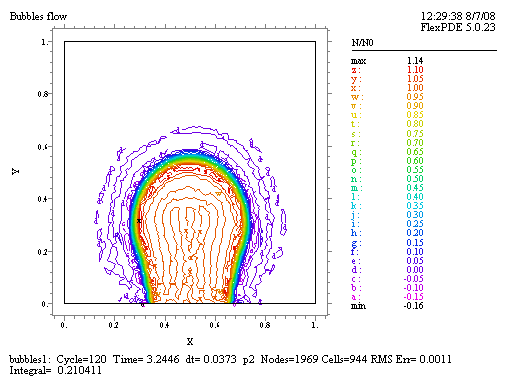| Author | Message | |||
Andrew Obraztsov (anobr) New member Username: anobr Post Number: 1 Registered: 08-2008 |
Hello, I try to model fluid flow and mass transfer problem similar a bubble column problem. I am using Navier-Stockes equation by Stream Function and Vorticity and mass transfer equation. Iíve got a problem with negative values of bubbleís number (variable - N). Have you got any ideas? I will appreciate any help. Thanks, Andrew
| |||
Robert G. Nelson (rgnelson) Moderator Username: rgnelson Post Number: 1154 Registered: 06-2003 |
There are several inconsistencies in this script. 1) Contours of the stream function are flow lines. Forcing psi=0 on the boundary says no material can flow across the boundary. You have tried to force flow in through a window in the bottom, but there is no escape, so the material must simply compress inside the box. I doubt this is what you wanted. 2) u and v should not be variables. They are simply the spatial derivatives of psi. It appears that you made them variables in order to try to impose the inlet velocity. But since v=-dx(psi), all you need to impose the inlet velocity is a ramped value condition on psi with slope -v0. 3) You have a natural BC on N, but there are no second-order terms in the N equation, so Natural(N) is undefined (See Natural Boundary conditions in the Help Index). The form of your BC implies that you intended material to flow out the top, but to do this, you need a ramped value condition on Psi along the top, rising to match the left end value in the window. The left boundary must then be constant at that same value. I have attached a modification of your script that corrects some of these things. I do not know if this models the system you had in mind, but it has eliminated some of the inconsistencies. The top boundary condition on psi is still not correct when the plume reaches the top. I have not tried to determine what it should really be.
 | |||
Andrew Obraztsov (anobr) New member Username: anobr Post Number: 2 Registered: 08-2008 |
Thank you for prompt reply. I tried different BC, but haven't got acceptable result. But you did it, great as expected! Yes, youíre absolutely right Iíve made v and u variables in order to impose the inlet velocity. As, Iíve already mentioned, Iím trying to simulate similar process as in bubble column reactors (gas injection into liquid). I havenít used classical Eulerian approach to this problem. Iíve accepted that the density of two-phase flow depends on the number of bubbles and applied Boussinesq approximation to NavierĖStokes equations. For bubbles Iíve used mass transfer equation. Of course, bubbles must flow out of the top while liquid should stay in the vessel. Now steam lines go out the top and show bubble flow lines. Perhaps, itís impossible to separate liquid flow and bubble flow (as liquid flow is forced by bubble flow (forced convection)) and they move together until the top? Or I should write a separate Navier-Stokes equation for bubble flow and therefore use Eulerian approach? I know your time is important and I value that, but could you please make some clarification for me? That lies behind BC for psi? Could you explain in more details why youíve assigned these values? Again, thank you for your help itís really important for me. Andrew | |||
Marek Nelson (mgnelson) Moderator Username: mgnelson Post Number: 63 Registered: 07-2007 |
We merely tried to remove inconsistencies in your original script working from the fact that you had imposed an inlet velocity for the fluid. If you are just injecting air and no fluid is flowing in or out, then it sounds like this is not the model you really want. It sounds like you want a closed system with the bubbles supplying a driving force for the fluid. But, we cannot be responsible for generating a model appropriate for your application. You should check the literature on the subject and see if you can find some discussion about these types of models. |